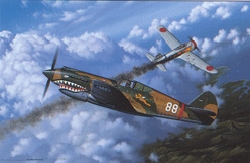|
|
| Tigers Claws |
|
 |

|
 |
|
|
| DESCRIPTION |
 |
| 16 x 11.5 Inch Collector Size Unframed Lithograph $40.00
Curtiss had been the primary supplier of fighter aircraft to the U.S. Army Air Corps. since its inception, and the company was dismayed when the Army procured the Boeing P-26 "Peashooter" in 1932. Curtiss responded by hiring Mr. Donovan Berlin, a bright young engineer who was working for Northrop. Donovan developed the Hawk 75, a streamlined, low-wing, monoplane coastal defense fighter. With an enhanced Twin Wasp engine the Hawk 75 evolved into the P-36, which had a brief and fairly undistinguished career with the Air Corps. In 1938 a P-36 was retrofitted with the Allison in-line 12-cylinder, 1150 HP engine, and the P-40 was born. This was the beginning of what would eventually be a production run of more than 13,000 aircraft. Depending on its theater of operation and the particular model, the P-40 was alternatively known as the "Tomahawk," the "Kittyhawk," or the "Warhawk." By mid-1942 P-40's were serving in every major conflict. The aircraft excelled in ground attack missions, but lacked the speed and maneuverability to challenge the top Japanese or German fighters in dogfights. As a result, P-40 pilots developed strategies which took advantage of the aircraft's structural integrity and excellent flying characteristics, while minimizing the aircraft's limitations. The final production version of the P-40 was the "N" model, which achieved a top rated speed of 378 MPH by eliminating two machine guns and by reducing fuel tank capacity. The American Volunteer Group was a group of American mercenary pilots which fought for the Chinese early in the War. Organized by Army Capt. C.L. Chennault, the Flying Tigers, as the group was more popularly referred to, consisted of 100 pilots and 100 P-40B aircraft. Three squadrons, the "Panda Bears," the "Hells Angels," and "Adam and Eve," made up the unit. The primary mission of the Flying Tigers was to keep China's vital supply link to the outside world, the Burma road, open. Under Chennault the Flying Tigers utilized diving attacks as a means of providing tactical advantage against the lighter, faster, and more maneuverable Japanese aircraft. Prior to the group being disbanded in 1942 the Tigers had chalked up 286 confirmed victories with losses of only 23 aircraft. Pilots received a $500 bonus for every Japanese plane shot down. Depicted in Stan Stokes extraordinary painting is Ken Jernstedt, one of the 39 Flying Tiger aces of the War, with 10.5 confirmed victories. In Stokes' scene Jernstedt has just achieved a victory over a Japanese Nakajima Ki-27, referred to as the "Nate" by the USAAC. The gnat-like Nate was the first monoplane fighter to serve with the JAAF. Although a fragile craft Chenault described the Nate as follows: "....it climbs like a rocket and maneuvers like a squirrel". The Flying Tigers did a lot of squirrel hunting in the few short months of their existence. |
|


|